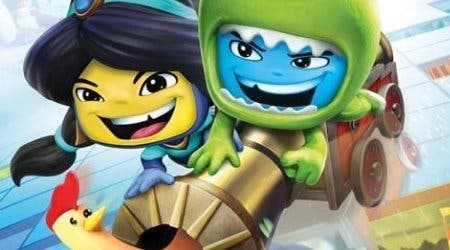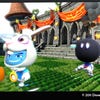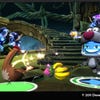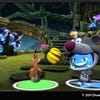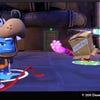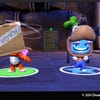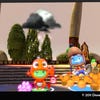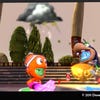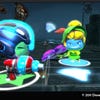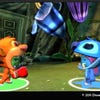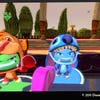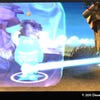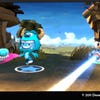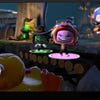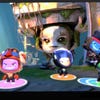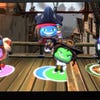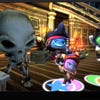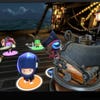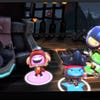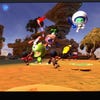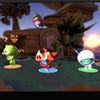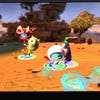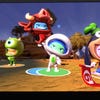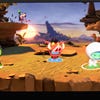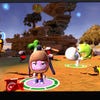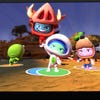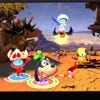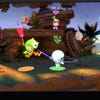Disney Universe Review
To Pluto and beyond.
The aesthetic is squint-view LitteBigPlanet, the soundtrack is a mixture of kindergarten chiptunes and sugary tween-pop and the building-block mechanics are lifted from the child-friendly Lego Star Wars. But despite these inspirations, Disney Universe also boasts one of the darkest premises in Disney's repertoire.
Employees at one of the corporation's theme parks - the cast members that deliver the dream day out for tiny children - have run amok. Rather than embodying all that is innocent and wonderful about childhood heroes, the employees have started attacking visitors. Paragons of security and cheerfulness have become malevolent dangers.
It's the stuff of true child nightmares; the edges of this story of broken trust are only softened only by the fact that the theme park is a 'virtual' Disneyland rather than a real one, and the employees aren't people but 'cast bots'. Even so, it's a dark heart at the core of an otherwise relentlessly saccharine game, one that delivers players into the world of six of Disney's most treasured properties: Aladdin, Alice in Wonderland, The Lion King, Pirates of the Caribbean, Monsters, Inc., and WALL-E.
You play as a blue-faced midget, a Sackboy prepped for work as an extra in James Cameron's Avatar, with a variety of unlockable costumes to clothe him in before you head into the game. These costumes range from the obvious (Mickey Mouse, Donald Duck) to the obscure (the lead ant from A Bug's Life) and their slightly oversized, floppy fit leads to some lovely animation, adding charm to what is a rather charmless base character.
Beyond the weapon you wield, your choice of costume has no mechanical implications, but since the game's emphasis is on co-op multiplayer this gentle bit of fan-service is welcome. New costumes are unlocked with the coins that you collect in-game, and the developer wisely places a primary emphasis on completing the entire wardrobe.
The game design is pulled from the now well-established Lego Star Wars template, although it lacks the diversity, richness and subtlety of Traveller's Tales' stable of games. In general, you move from left to right through a short, contained area, solving straightforward lock-and-key puzzles in order to progress while batting the attacking bots away into showers of coins that can be hoovered up and spent to unlock new content.
Each stage contains a secret blue star that, when collected, permanently upgrades your chosen costume, increasing the size and effectiveness of your melee weapon. The combat, while button-mashy for the audience, has shades of Kingdom Hearts in it, especially as many of the characters' weapons resemble keyblades.
But with just one attack button and a jump, there's none of the relative complexity of Square Enix's work here. Fighting grunts fast becomes boring, your weapon slicing through their attacks with ease, although larger brutes require some strategy, temporarily elevating the combat to something more interesting.
Collectibles and pick-ups litter the environments: power-ups that momentarily grant your character giant boxing gloves or a huge, foe-pulling magnet, for example, giving the illusion of a generosity of content. Indeed, first impressions of the game are strong thanks to the vibrant visuals, tight control and rapid stream of rewards.
"There's little reason to play through a stage more than once - again in contrast to the Lego games."
But in reality, aside from three easily-found hidden objects in each level, there's little reason to play through a stage more than once - again in contrast to the Lego games, which pile high the incentives for repeat play and exploration. Some costumes can only be unlocked by playing a stage twice, but when you are doing so solely to acquire a meta-reward, it's a somewhat joyless experience.
Level design is robust, but rarely imaginative. Too often the designs fall back on the same tight set of ideas: piecing together a cannon by pulling the two halves together, then pushing it to a designated spot in order to shoot down a door or a pirate ship, for example. Repetition becomes an issue as the game unfurls.
The special case levels are often the strongest, playing with the formula in more interesting ways, but these are too few to upset the wider rhythm. A large blue arrow indicates where you should be headed or what you should be interacting with at any given point; it's a useful addition for younger children that can be turned off in the menu if you want to make the game more than an explicit, linear to-do list.
While the game lacks lustre in single-player, there is more fun to be had with up to three friends. With a full set of co-operating players, the small play areas can become very cramped, especially with the showers of coins and particle effects that confuse the screen. But with one or two friends in tow, the co-op mechanics that have players coming together for special moves elevate the experience somewhat. The game design has been properly reconfigured for multiplayer, with puzzles tweaked to require timed inputs from each participant: an effort that should be applauded, even if it fails to do away with the more fundamental issues of repetition and uninspiring design.
Disney Universe is far from a bad game. Its general competency is evidence of a capable team that has cherry-picked designs (both systemic and aesthetic) from other titles and paired them with a clutch of inspiring licenses. But the disparate parts only click together in a rather mundane way, failing to capitalise fully on the licenses or match up to the quality of its video game inspirations. As a result, the game comes across as a pastiche that lacks its own vision and identity - a world away from all that it could have been, considering the stars it had to play with.
